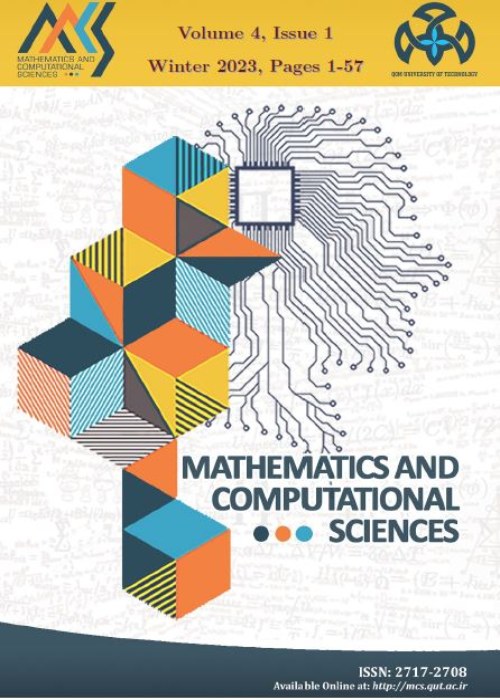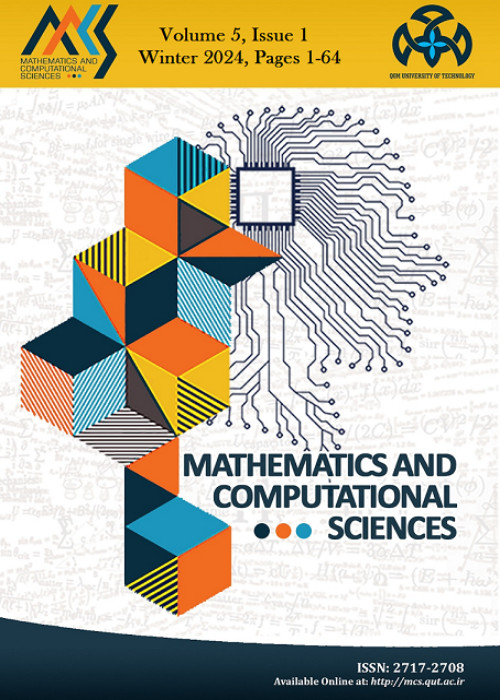فهرست مطالب

Mathematics and Computational Sciences
Volume:4 Issue: 1, Winter 2023
- تاریخ انتشار: 1401/12/10
- تعداد عناوین: 6
-
-
Pages 1-8This paper considers the collocation method for the numerical solution of the Volterra integro- differential equation using polynomial basis functions. The modeled equation was converted into a linear algebraic system of equations and matrix inversion was employed to solve the algebraic equation. We substitute the result of algebraic into the approximate solution to obtain the numerical result. Some numerical problems are solved to show the method's efficiency and consistency.Keywords: collocation, Volterra, Integro-differential, Basis polynomial, Approximate Solution
-
Pages 9-17In this article, we study a new nonlinear Langevin equation of two fractional orders with fractional boundary value conditions which is a generalization of previous Langevin equations. Based on Banach and Schauder fixed point theorems, the existence and uniqueness of solutions of this equation are investigated. Moreover, our hypotheses are simpler than similar works.Keywords: Fractional Langevin equation, Fractional boundary condition, Existence solution, Fixed point theorem
-
Pages 18-28First-kind Chebyshev polynomials are used as the basis functions in this study to present the approximations to the eighth-order boundary-value problems. The problem is reduced using the suggested approach into a set of linear algebraic equations, which are then solved to determine the unknown constants. To demonstrate the application and effectiveness of the strategy, analytical results are provided using tables and graphs for three examples. The results obtained using the proposed method reveal that it is simple and outperforms comparable solutions in the literature.Keywords: First kind Chebyshev polynomials, Boundary value problems, collocation, Approximate Solution
-
Pages 29-35Face recognition is an essential field of image processing and computer vision. In this paper, we have developed a facial recognition system that can detect and recognize the face of a person by comparing the characteristics, and features of the face to those of known faces. Our approach considers the face recognition problem as an intrinsically two-dimensional recognition problem rather than requiring recovery of three-dimensional geometry, considering that eigenvectors generally describe human faces in the face space. The system works by projecting face images onto a feature space that spans the significant variations among known face images that are called eigenvectors (or principal components of the face set). Our technique can learn and recognize new faces in an unsupervised style—this approach is based on eigenfaces and principal component analysis (PCA).Keywords: Eigenfaces, Face Recognition, Principal Component Analysis (PCA)
-
Pages 36-44It is challenging to follow all nutritional requirements simultaneously. A good mathematical tool for converting nutrient-based suggestions into realistically nutritionally ideal food combinations integrating locally accessible foods is the diet optimization model. The objective of this study is to design a linear programming model that figures out how many grams of each food type need to be mixed to produce an instant meal complement for infants between the ages of 6 and 23 months. The mathematical model developed computes the grams of each food type – Quelea mixed with either Green Banana or White Rice or Irish Potato and Onions, Tomatoes, Carrots and Green bell Pepper. When those foods were combined, an instant food complement will be created and entirely satisfy the preset needs of malnourished infants. Thus, Tanzanian public health technologists and nutritionists may apply the linear programming approach explored in this study to create new ready-to-use food formulations.Keywords: Malnutrition, Linear Programming, Instant Compliment Food, Food Type, Quelea
-
Pages 45-57In this work, we focus on the final value problem of an inverse problem for the pseudo-parabolic equation. This study aims to provide a regularization method for this equation, once the measurement data are obtained at the final time in $L^{r}(0,\pi)$. We obtain an approximated solution using the Fourier method and the final input data $L^{r}(0,\pi)$ for $r \neq 2$. Using embedding between $L^{r}(0,\pi)$ and Hilbert scales $\mathcal{H}^{\rho}(0,\pi)$, this study is the error between the exact and regularized solutions to be estimated in $L^{r}(0,\pi)$.Keywords: Source problem, Fractional pseudo-parabolic problem, Ill-posed problem, Convergence estimates, Regularization


